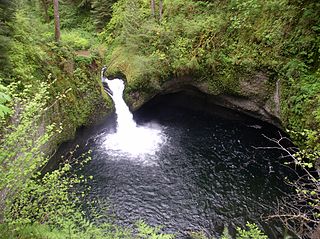Related Research Articles

Plymouth Township is located in Luzerne County, Pennsylvania, United States. The population was 1,712 at the 2020 census.
The Skatin First Nations, aka the Skatin Nations, are a band government of the In-SHUCK-ch Nation, a small group of the larger St'at'imc people who are also referred to as Lower Stl'atl'imx. The Town of Skatin - the St'at'imcets version of the Chinook Jargon Skookumchuck- is located 4 km south of T'sek Hot Spring- alt. spelling T'sek Hot Spring - commonly & formerly named both St. Agnes' Well & Skookumchuck Hot Springs The community is 28 km south of the outlet of Lillooet Lake on the east side of the Lillooet River. It is approximately 75 km south of the town of Pemberton and the large reserve of the Lil'wat branch of the St'at'imc at Mount Currie. Other bands nearby are Samahquam at Baptiste Smith IR on the west side of the Lillooet River at 30 km. and Xa'xtsa First Nations; the latter is located at Port Douglas, near the mouth of the Lillooet River where it enters the head of Harrison Lake. The N'Quatqua First Nation on Anderson Lake, between Mount Currie and Lillooet, was at one time involved in joint treaty negotiations with the In-SHUCK-ch but its members have voted to withdraw, though a tribal council including the In-SHUCK-ch bands and N'Quatqua remains, the Lower Stl'atl'imx Tribal Council.
The Bonaparte River is a tributary of the Thompson River, joining it at the community of Ashcroft, British Columbia. The river is about 150 kilometres (93 mi) long, including the 17 kilometres (11 mi) length of Bonaparte Lake. Rising on the Silwhoiakun Plateau to the northwest of Kamloops, the Bonaparte River flows west and south to join the Thompson River.
Slim Creek Provincial Park is a provincial park in British Columbia, Canada.

Shining Tree is an unincorporated community in the Canadian province of Ontario, located on Highway 560 in the Sudbury District. It lies on the east of West Shining Tree Lake.
College Corner is an unincorporated community in Wayne Township, Jay County, Indiana.
Hogshawe or Hogshaw is an area of settlement in Derbyshire, England. It is a part of Buxton, located between the A6 Fairfield Road and the present Peak Rail railway line. By the 1890s the area had been enclosed on the west and north sides by the London and North Western Railway and Midland Railway lines, with Lightwood Road running across from south-east to north-west. The area falls in the Corbar ward of the High Peak Council.

Williams Creek is an important historical gold mining creek in the Cariboo goldfields of the Central Interior of British Columbia, entering the Willow River between Barkerville and the town of Wells, which is at the headwaters of the Willow River.

Eagle Creek is a tributary of the Columbia River in Multnomah and Hood River counties in the U.S. state of Oregon. It cuts through a narrow canyon in its 3,200 feet (980 m) descent to the Columbia River Gorge and is known for its concentration of 13 waterfalls in about 5 miles (8.0 km) distance. Eight major falls are on Eagle Creek and the East Fork Eagle Creek itself, while five are on its tributaries.
Jumbo is an unincorporated community in western Pushmataha County, Oklahoma, United States, 10 miles north of Miller.

Antler Peak, el. 10,063 feet (3,067 m) is a prominent mountain peak in the Gallatin Range in Yellowstone National Park. The peak was originally named Bell's Peak in honor of an Assistant Secretary of the Interior by either Philetus Norris, the second park superintendent or W.H.Holmes, a U.S. Geological Survey geologist in 1878. However, in 1885, Arnold Hague of the U.S. Geological Survey renamed the peak Antler Peak because of the numerous shed elk and deer antlers found on its slopes.
The Oscar Wilde Centre is an academic research and teaching unit in Trinity College Dublin. It was founded in 1998, and is located at 21 Westland Row, the house in which Oscar Wilde was born. This building, which is on the perimeter of Trinity, was purchased in the 20th century as part of an expansion programme. The centre offers two post-graduate programmes: the MPhil in Irish writing, and another in creative writing – the first programme of its kind in Ireland. The centre was founded by the poets Brendan Kennelly and Gerald Dawe, who serves as the director. Richard Ford, a Pulitzer Prize-winning American writer, joined the staff in 2008 as an adjunct professor.
Dragon Creek is a creek located in the Cariboo region of British Columbia. The creek was discovered in the 1860s by a Frenchman nicknamed The Dragon because of his fighting abilities. The creek has been mined using drifting, sluicing, hydraulicking and drilling.
Jack of Clubs Creek is a creek located in the Cariboo region of British Columbia. This creek was discovered in 1861. It was mined and yielded about $450,000 in gold during the early years. A survey in 1987 found the tailings deposited in the valley were leaching heavy metals into the water, and that the concentrations of mercury in fish caught in the area were at the upper limit of safety for human consumption.
Keithley Creek is a creek located in the Cariboo Region of British Columbia. The creek flows into Cariboo Lake from the west. It was discovered in 1860 by "Doc" Keithley. The creek has been hand mined and hydraulicked for gold.
Lowhee Creek is a creek located in the Cariboo region of British Columbia. The creek was discovered in 1861 by Richard Willoughby who struck it rich here in 1861. He named it after a secret society at Yale University. The creek was mined for gold and was productive in the 1860s. The richest ground was where the stream flows into the meadows. This creek has been worked using sluicing, drifting, and hydraulicking.
Mosquito Creek is a creek in the Cariboo region of British Columbia. The creek is a tributary of Willow River. This creek was discovered to be gold bearing in 1861. It has been mined and produced an estimated $3,500,000 in gold.
Hart Creek is a stream in Perkins County in the U.S. state of South Dakota. It is a tributary to Thunder Butte Creek.
References
- ↑ N.L. Barlee (1980), The Guide to Gold Panning, Revised Second Edition, Second Printing. Canada West Publications., ISBN 0-920164-04-8